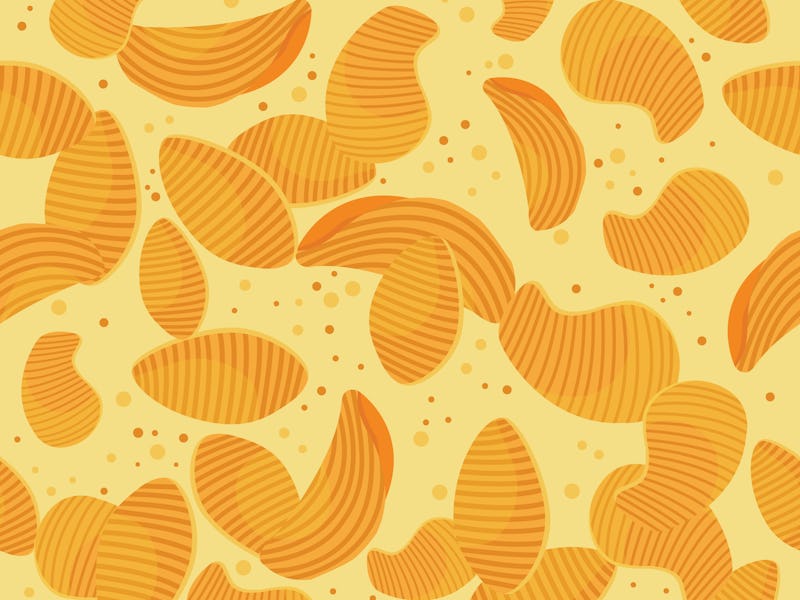A new potato chip paradigm can save the planet
Your favorite snack is getting a green upgrade.

Potato chips are arguably one of the world's best snacks. But creating enough potato chips to fuel the worldwide demand has its downsides — namely, increased carbon emissions from manufacturing.
Walkers, the British equivalent of Lay's chips in the United States, appears to be trying to change this production paradigm. In a recent report, Walkers announced it partnered with the technology company CCm to transform carbon emissions from chip production back into fertilizer for growing spuds.
Once fully up and running, Walkers predicts the technique will reduce its carbon emissions by 70 percent and could eventually lead to a future in which every potato chip is carbon negative.
Why it's newsworthy — The secret ingredient in this technological recipe is one that typically elicits scorn rather than excitement: Carbon capture.
Carbon capture proposes literally snatching carbon from the atmosphere and storing it or using it in further production. A solution that doesn't tackle the root cause of the problem of greenhouse gas emissions — climate change — scientists are not universally excited about carbon capture. Aside from the environmental qualms are the design issues — so far, creating a carbon capture approach that actually works has proven a challenge.
But representatives from CCm and Pepsico, Walkers' parent company, tell Inverse the companies are confident this time they can actually pull it off.
"The main thing that has made carbon capture difficult in the past is that it usually requires the separation of the CO2 and the capture medium," a spokesperson for the two companies tells Inverse. "This can be complex and carries a large energy burden."
"The reason that the CCm method is different is that it does not require any post capture separation of the CO2 from the capture medium as it retains all the materials required for capture in the product for sale. Furthermore all the ingredients included in the mixture have an active beneficial role in the end product allowing their value to be recognized in full."
For Walkers, the "capture medium" in question is leftover waste from the potatoes themselves — peels.
How it works — Before potatoes can be used to transform carbon emissions, they first have to be harvested and brought to Walkers for processing. After the potatoes are washed and peeled, the tasty insides are taken away for cooking, while the peels are taken a separate route for "anaerobic digestion."
In other words, to be chemically broken down and have energy recovered in the form of biogas.
Anaerobic digestion is nothing new for Walkers. In fact, this process powers up to 75 percent of the plant's energy, so adding the extra step — carbon capture — wasn't so much reinventing the wheel as improving upon it.
What's left of the potato peels after the anaerobic digestion process go through CCm's technology. Their ammonia levels are artificially increased, allowing them to act like a butterfly net to catch carbon dioxide collected from the factory. The gaseous carbon dioxide then reacts with the ammonia in the peels to create a liquid solution of bicarbonate and ammonia, which is then stabilized by the addition of calcium and nitrate ions.
What sounds like a mad concoction of chemicals is actually a chemical recipe for nutrient-rich fertilizer.
"The final product can be viewed as an organic base material within which the plant nutrients held fixed in place by a chalk matrix," the spokesperson says.
This dense matrix of plant nutrients is then made into pellets to be returned to the potatoes fields to nourish the next crop.
Every year, Walkers uses 340,000 tonnes of potatoes to make their crisps.
How this can be used — So far, Walkers has tested the technique out on 3-4 acres of potatoes — but using CO2 emissions from beer fermentation instead of their own potatoes to start. The carbon capture-fertilized potatoes grew just as would have been expected with any other fertilizer, the company says.
"This is very encouraging," Walkers' and CCm's spokesperson says. "We already know that the fertilizer is ultra-low in carbon when compared to traditional fertilizer, and there aren’t any barriers to entry by using CCm fertilizer, as it can be supplied and applied in the same way as traditional fertilizer."
While it is too soon to say for sure, the companies anticipate that this carbon sequestration process will ultimately improve soil health as well.
See also: Climate Change: Robots on farms could fight emissions and grow more food
What's next — Following the success of its trials, Walkers plans to install CCm's carbon-capture equipment at its Leicester factory, the company's home base, in 2021.
"Our aim is to produce as much fertilizer as possible to use on our 2022 UK crop," the spokesperson adds. "This is when we’ll begin to see the real impact of the fertilizer on our potato-based carbon emissions."
With these upgrades, Walkers expects to lower carbon emissions by 70 percent and potentially even reach carbon negative production in the next decade. But that depends on future improvements to the technology, natural carbon sequestration from the soil, and other sustainable initiatives being successful, too, like reducing water usage.
In the future, Pepsico, Walkers' parent company, hopes to use the approach to transform production of their other crops, including oats and corn — and even food systems beyond their reach.
"The technology is directly transferable to other food systems and importantly is able to make use of the different nutrient profiles that can be held within alternate crop and waste sources," the spokesperson says.
With any luck, many of our favorite snack foods might not only be good for the soul, but good for the planet, too.